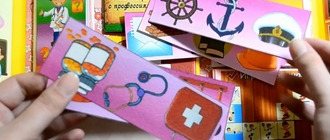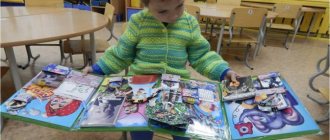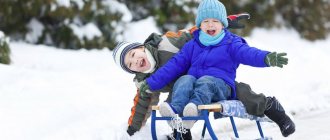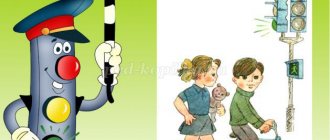In Russia, there has been a law in force for more than 7 years, according to which kindergartens must create a special environment for the development of children with disabilities. We tell you what conditions children with disabilities need and how to organize work with “special” children in preschool.
- Disability and Disability: The Difference
- Where can children with disabilities study?
- What conditions are needed for children with disabilities in kindergartens?
- Forms and methods of work of a teacher with children with disabilities
- Benefits and additional payments for teachers working with children with disabilities
Disability and Disability: What's the Difference?
Children with disabilities are often confused or compared with children with disabilities. These are different concepts and it is important to understand their differences.
A child with disabilities has a regular or temporary deviation in physical or psychological development. For example, he has poor vision or hearing, stutters or has other speech impairments, is mentally retarded, or suffers from autism. Such disorders may be temporary or permanent, mild or severe. As the child develops, they may completely become a thing of the past. The diagnosis of “disability” is not always made by a doctor; it only means that this baby is special and needs an individual approach.
Disability involves significant impairment of body functions. They could be the result of an injury or birth defect in the child. These deviations are difficult to eliminate or cannot be eliminated, so the diagnosis is not removed from the child for years, and sometimes throughout his life. Disability is established by expert doctors at a medical and social commission, has an official status and presupposes the availability of benefits and payments to the child’s parents.
Children with disabilities and disabled children need special conditions for development and learning, attention and care. They are trained using a similar methodology, the features of which depend on the type and severity of the disease.
Socialization of children with disabilities in preschool educational institutions: from theory to practice
Bibliographic description:
Socialization of children with disabilities in preschool educational institutions: from theory to practice / T. V. Reznichenko, A. Yu. Karnaushchenko, O. Yu. Sochneva [and others]. — Text: immediate // Education: past, present and future: materials of the VI International. scientific conf. (Krasnodar, May 2022). - Krasnodar: Novation, 2022. - pp. 18-21. — URL: https://moluch.ru/conf/ped/archive/330/15041/ (access date: 02/05/2022).
The research work reveals the experience of preschool educational institutions and contains a description of a model of successful socialization of children with disabilities tested in practice, generalizes theoretical and practical developments on the organization of a single integrated space for the socialization of pupils with developmental disabilities.
The material presented in the article will be useful to teachers of educational organizations of various types working with children with disabilities.
Key words: socialization, optimal model, preschooler with disabilities, integrative field, concept of social development.
MADOU "Combined Kindergarten No. 200" is a combined educational organization that provides special (correctional) services for children with disabilities. In the preschool educational institution there are 4 correctional groups for pupils with disabilities who have various disabilities (mental developmental disabilities, mental disabilities, autism spectrum disorder, TMPD). Most children have the status of a disabled child.
Kindergarten is an open educational space, the task of which is to develop the universal social abilities of our pupils, mastering social culture, norms of communication and interaction with peers, parents, preschool teachers, taking into account the specifics of their individual and psychophysical capabilities.
The main problem of a child with disabilities is the disruption of his connection with the world, the lack of contacts with peers and adults, limited communication, the inability to navigate the surrounding life, observing certain rules and norms of behavior, the inability to understand the meaning of a number of cultural, moral and ethical values society.
Many preschoolers with disabilities are unable to independently enter the sphere of social relations and master communication skills, as they have difficulties in adaptation, social-emotional deprivation, insufficient or distorted development of voluntary regulation of emotional and behavioral manifestations, increased anxiety, uncertainty, low or high self-esteem, lack of initiative, lack of independence, lack of curiosity and activity.
The above listed features of preschoolers with disabilities determine the relevance of this research work.
The goal of the work is to create conditions for the successful socialization of preschool children with disabilities.
The preschool teachers identified the following tasks:
– increasing the professional competence of all participants in the socialization process;
– development and testing of an optimal model of correctional and educational activities as a single integrated field for the socialization of preschool children with disabilities;
– development of a system of diagnostic tools and criteria for assessing the level of formation of the socialization process of preschoolers with disabilities;
– exchange of experience, methodological developments, recommendations for various categories of teaching staff on the use of the socialization system for preschool children in practice.
Object of study: pupils of correctional groups of preschool educational institutions with disabilities.
Subject of research: problems of socialization of children with disabilities in society.
Practical significance: creation and testing of an optimal model of correctional and educational activities as a single integrated field for the socialization of preschoolers with disabilities.
hypothesis : the process of socialization of preschoolers with disabilities will have positive dynamics if an effective model of a single integrated space is created in the preschool educational institution.
Research methods: theoretical (study and analysis of literature, regulations); sociological (conversations, surveys); pedagogical experiment, monitoring, analysis, generalization and systematization.
Our preschool institution has paid attention to this problem and has been deliberately dealing with it for many years. (“Municipal Experimental Site” 2011–2012; “Municipal Innovation Site” 2013–2014; City Panorama of Innovation Experience “Virtual Site” 2015, 2016, 2017)
Based on our many years of experience, we have developed an optimal model of interaction between all participants in the correctional and educational process for the successful socialization of children with disabilities in an educational institution.
The basis for the development of the optimal model was the Concept of social development of preschool children “On the Road of Goodness”, ed. L. V. Kolomiychenko. In this concept, socialization is considered as “the process of familiarization with social culture, social adaptation of the individual in society, individualization as a process of isolation, the formation of universal social abilities that characterize the degree of social independence of the individual, and cultural creativity.” [1]
In their work they relied on general scientific pedagogical approaches:
– axiological approach (identification of priority communicative, cognitive or subject-practical values in the education, upbringing and self-development of a preschooler with disabilities);
– cultural approach (taking into account national values and traditions, introducing the child to the main components of human culture); [2]
– humanistic approach (recognition of the child as an individual, focus on his needs and interests, rights and freedoms, psychological comfort);
– anthropological approach (psychological and pedagogical diagnostics in determining the dynamics of social development of a preschooler with disabilities);
– multi-subjective approach (taking into account the specifics and influence of the micro- and macroenvironment on a child with disabilities);
– system-structural approach (organization of an integral pedagogical system of correctional, developmental and educational environment);
– an integrated approach (integration of all components of the pedagogical process: cognitive, speech, social-communicative, artistic-aesthetic, physical);
– activity approach (the child’s relationship with the outside world, the realization of his needs in various types of activities);
– environmental approach (organization of a socializing subject-educational space).
Rice. 1. Model of socialization of preschool children with disabilities in preschool educational institutions
At the center of our model is a child (a preschooler with disabilities), around him all subjects of the social environment are involved and are in close partnership and interconnected: the community of peers, family, employees, and social partners of the preschool educational institution.
Interaction with each of these groups leaves an indelible mark on the child’s mind and influences his personal and social development.
The cooperation of all subjects of interaction is aimed at organizing a single integrated space for the socialization of pupils with disabilities, which includes:
– regulatory and legal support of the process;
– software and methodological equipment;
– consultative and diagnostic support for pupils and families;
– organization of a professional, pedagogically appropriate educational environment;
– creation of a comfortable, accessible, variable subject-spatial environment;
– organization of leisure activities.
We see the effectiveness of this model in the successful adaptation and socialization of our students in a kindergarten, optimization of the correctional and developmental field as a whole, in nurturing tolerance among all participants in the educational process, increasing the level of pedagogical competence of the kindergarten staff and the active participation of parents in the life of the preschool educational institution.
During the control period of 2016, 2022, 2022, three control sections of the final monitoring of pupils of correctional preparatory groups of preschool educational institutions were carried out.
32 graduates - 2016, 28 graduates - 2022, 34 graduates - 2018.
The results are presented in the diagram.
Results of monitoring the integrative qualities of preschool educational institution graduates for the control period 2016–2018 (%)
Rice. 2. Results of monitoring of integrative qualities
The obtained indicators allowed us to draw the following conclusion :
The share of pupils at the end of their stay in a preschool institution who have positive results in personal and social development over 3 consecutive years is close to 100%.
The obtained research indicators allowed us to conclude that the implementation of the created model contributes to the formation of integrative qualities in children with disabilities:
– the majority of graduates of correctional groups of preschool educational institutions have increased interest in subjects of the surrounding world, experimental and design activities, and use the information received in various types of activities;
– from 93% to 97% of children have ideas about themselves, their family, society, state, world and nature;
– 96% - 98% show independence and activity in everyday life;
– about 100% of students are able to negotiate, distribute actions, and change their communication style;
– all children with disabilities have begun to respond more adequately to external stimuli, are able to control their behavior, and comply with basic social norms and rules of behavior.
– 99% of preschoolers correctly understand and identify the various emotional states of peers and adults in real life and in fiction, and show compassion and care for loved ones and animals.
Evidence of the effectiveness of the work being carried out is the preservation and improvement of social and personal results during the transition to the next stage of training.
Monitoring of socialization showed that students have consistently positive dynamics. Children successfully adapt to a new social environment, gradually learn to build a strategy for independent living, establish new social contacts, and demonstrate a sufficiently high level of readiness for independent living.
We believe that this work experience on the topic “ An optimal model of socialization as one of the conditions for the successful social development of children with disabilities in preschool educational institutions” is relevant and recommended for specialists working with children with disabilities in educational institutions of various types , and is also used in the training and retraining of teachers in correctional work with children with disabilities.
Literature:
- Kolomiychenko L.V. “On the path of goodness” Program on social and communicative development and social education of preschool children. - M.: TC Sfera, 2015. - 192 p.
- The main educational program of preschool education “From birth to school”, ed. N. E. Veraksy, M. A. Vasilyeva, T. S. Komarova. -M.: Mozaika-Sintez, 2022. - 352 p.
- Triger R.D. Psychological features of socialization of children with mental retardation. - St. Petersburg: Peter, 2008. - 192 p.: ill. — (Series “To the Child Psychologist”).
- Socialization of children with disabilities at the present stage: scientific, methodological and applied aspects: Collection of scientific and methodological materials / ed. Belogurova A. Yu., Bulanova O. E., Polikasheva N. V. - M.: Sputnik+ Publishing House, 2014. - 335 p.
Key terms
(automatically generated)
: kindergarten, limited health, optimal model, child, single integrated space, social development, preschool institution, single integrated field, control period, research work.
Where can children with disabilities study?
Children with disabilities can attend specialized or regular kindergartens. The choice of group and institution depends on the severity of the child’s disabilities. There are two main training options.
1. Kindergartens or compensatory groups These are special groups that are aimed at correcting pathologies in children. They are usually attended by preschoolers with serious physical and mental disabilities. Children with similar types of disabilities are assigned to each group and are taught within the group according to a single program.
2. Combined groups This group combines normal children and preschoolers with disabilities. The group should have no more than 15-17 people. Moreover, there may be only a third of this number of children with disabilities. Combined groups are suitable for children with minor developmental disabilities. But it is also important to create special conditions for them. The teacher works with “special” children according to an individual adaptive program. If children have different types of disorders, then the development program is drawn up individually for each.
The decision on which form of education is suitable for a particular child is made by a psychological, medical and pedagogical commission. The student undergoes a full examination and receives a conclusion. In addition to the conclusion, recommendations are attached that indicate the conditions for the child’s comfortable learning.
What conditions are needed for children with disabilities in kindergartens?
Children with disabilities, due to circumstances, get used to constant parental care, so it is difficult for them to adapt to society. They often have little interaction with other children and virtually no participation in group games. It is important to create an environment that will help children develop basic interaction skills. For example, prepare for life in society, develop speech, social and motor skills, as well as self-care skills.
To do this you need:
- Arrange the territory of the kindergarten in such a way that the child can move freely, regardless of possible physical limitations.
- Create a favorable atmosphere in the group, preparing healthy children for the arrival of a child with special needs. The teacher’s task is to create an environment in which every child feels comfortable, adhering to the principle of equality and without violating the rights of ordinary children. At the same time, it is important to ensure that a friendly atmosphere is maintained in the group. Encourage mixed games where kids play together, do not emphasize the differences of a child with special needs in front of other children. Be the bridge through which the child finds his first friends. Remember that the child’s psyche is flexible and very quickly takes for granted any characteristics of classmates in the garden if adults treat them calmly and kindly.
- Involve not only educators, but also other specialists in working with children. The program should include: a psychologist, speech therapist, speech pathologist, health worker, music director and physical education instructor. They evaluate the child’s behavior, his reactions to various situations, and conduct additional individual or group lessons. Then they observe the results, make the necessary recommendations and report them to parents. In this way, it will be possible to ensure the comprehensive development of the child - physical, artistic, speech and social.
- Study the characteristics of each child and the recommendations of the medical board. Based on this, create an individual development plan. Despite the possibility of joint education for ordinary children and children with disabilities, the forms and methods of education for children with a diagnosis differ from the standard ones.
Organization of work with preschool children with disabilities in preschool educational institutions.
Adapted educational program of preschool educational institution
This program, according to the Federal State Educational Standard, implements the training and education of children with disabilities in accordance with their development, characteristics, and individual capabilities. In addition, she corrects, if necessary, problems with the child’s adaptation to social society.
Individual correctional and developmental route for a child with disabilities
General methods for preschool education are not suitable for all students. For some, it is quite difficult to study according to such a program, for others, on the contrary, there is not enough knowledge for further development. For this reason, new training systems are being developed that take into account all the individual qualities of all children individually. They are presented in the form of an individual educational route for children with health problems in a preschool educational institution.
It is developed by specialists, gradually setting goals and objectives, using pedagogical resources, methodological techniques and the results of individual educational methods.
Forms and methods of work of a teacher with children with disabilities
During training, children with disabilities often get tired quickly, respond slowly to requests, and find it difficult to maintain attention on one task. These features should be taken into account when choosing a form of training. For example, you should reduce the duration of classes, change activities more often, and allocate more time to any task. But this does not mean that a child with disabilities needs to be separated from the main group. It is important to find abilities, identify the child’s predispositions and rely on them in learning.
The main task of the teacher in group work is to find those methods that will be accessible and interesting to all group members. Psychologists recommend including three main methods in your plan.
Play therapy
This is a psychological tool that influences children through play. In a relaxed atmosphere, children learn to interact with other people, explore the world and expand their horizons. The game helps to understand exactly what difficulties a particular child is experiencing and correct them.
Children with disabilities will benefit from musical games or exercises in the sensory room. This is a specially equipped room that helps stimulate all forms of perception: olfactory, tactile, auditory, visual, gustatory and vestibular.
Psycho-gymnastics
These are sets of exercises and games that help relax muscles, express feelings and become emotionally liberated. Such exercises develop the cognitive, emotional and personal sphere. The simplest example of psycho-gymnastics is the game “Do as I do.” The teacher shows expressive movements, and the children repeat.
Fairytale therapy and puppet therapy
Fairytale therapy allows you to immerse a child in a certain situation using the example of fairy-tale characters. In this way, he develops his imagination, learns to cope with fears and live through his emotions. Fairytale therapy is effective for children who have difficulties in the physical, emotional and behavioral spheres. Fairy tale therapy is a method of working with children through fairy tales. Puppet therapy works on the principle of fairy tale therapy, only instead of a fairy tale, the teacher performs a puppet theater.
Article on the topic “From the experience of an inclusive kindergarten”
The 21st century can be called a time for people to rethink their place and role in the world. There is a tendency to develop such processes as understanding tolerance towards people with disabilities and the development of inclusive education. In recent years, Russia has been pursuing an active policy to introduce inclusive education, which is under the close supervision of society and is actively included in our culture.
As part of the innovative educational model “Inclusive Kindergarten”, in the MBDOU “Combined Kindergarten No. 29”, along with general education groups, there is a resource group for children with ASD, a lekotek and 2 compensating groups for children with STD. For three years, kindergarten specialists have been working on the comprehensive development of children with disabilities. It is worth noting that along the way of project implementation, the teaching staff has to face various difficulties and difficulties in achieving their goals and objectives.
We divided our work on organizing inclusive education into three areas:
— continuous improvement of teachers’ skills in working with children with disabilities;
— correct building of interaction between normotypical children and their parents with children with disabilities;
— working with parents of special children.
In the interests of improving teachers’ skills in working with children with disabilities, the following is carried out:
— constant monitoring and study of problems (professional difficulties);
— course retraining and training of teachers;
— seminars, conversations and consultations on social and psychological aspects in the management of a child with disabilities with highly specialized specialists.
This kind of event helps teachers develop an understanding of the processes of inclusive education, and protects them from comparing students with each other.
The problem of social adaptation of children with disabilities can be successfully solved only in the close cooperation of a prosperous environment for all pupils, which includes, in addition to teachers, also parents.
However, not all parents of normative children are ready to accept the joint development of their children with special children. Many people are afraid that being in a group with a child with disabilities will somehow harm their child. This circumstance has a negative impact on the educational process of both children with disabilities and normotypical children, since it is in the family that the child receives his first knowledge about interacting with people, learns respectful and patient communication with them, and the example of parents is of great importance for acquiring tolerant behavior.
The teaching staff conducts educational work with parents of students to develop a tolerant attitude towards children with disabilities. The work is carried out through various forms of interaction:
-conversations (“Let’s turn face to face”, “We are together”);
— thematic parent meetings;
— individual and group consultations;
- joint activities and holidays.
Involving parents in the upbringing process made it possible to achieve understanding between parents of children with disabilities and parents of normotypical children.
The results of inclusive education fully depend on the culture of relations of all participants in the educational process. A huge role in this process is played by the development of knowledge and skills among parents of children with special needs to communicate with their children. Often situations arise when the parents of such children either do not see the prospects for the development of their child, or, on the contrary, overestimate the achievable level of development of the child, without correlating with his real capabilities.
At the preschool educational institution, such parents receive support from highly specialized specialists who work with their children. Work is carried out in the following areas:
— familiarize yourself with the stages and patterns of the child’s psychophysical development;
— explain the importance of classes for the psychophysical and intellectual development of the child;
- develop practical skills and abilities in the field of interpersonal communication (mother - child);
- form a positive attitude towards every minor success of the child;
— teach them to adequately assess their child’s capabilities.
For this purpose, a series of activities has been developed in which targeted work is being carried out to involve parents in the creative process and playful interaction with their children to promote emotional communication with children and the development of interaction with each other.
At the beginning of their work, specialists faced a number of problems:
- many special children are systematically weakened and cannot always take part in all types of activities;
- parents of such children, due to a degree of distrust of others, consider their children inferior, they are closed in communication.
However, the positive attitude of the teachers of our preschool educational institution changed the attitude of the pupils and their parents to the work being done. Now we can say with confidence that for many parents the need to develop the skill of establishing trusting relationships with their children has been satisfied. It was possible to break down the barrier in establishing contact between children and parents of other groups. Our students have begun to develop a moral concept and are learning to listen to each other.
Today we can say with confidence that the preschool educational institution staff, students and their parents are a big friendly family. And despite all the problems, experience shows that the creation of such inclusive kindergartens contributes to the social adaptation of children with disabilities from early childhood, the development of their autonomy and independence, and also pushes society towards a tolerant attitude towards such people. Teaches children to see others as equals, regardless of their characteristics. Allows you to instill respect for all people without exception. With inclusive education, all children benefit, not just children with disabilities.
List of sources used
1 Bogdanova, T.G. Problems of psychological support for inclusive education of children with disabilities // Child with disabilities in the modern inclusive educational space: problems, ways of help, prospects. - Perm: PGGPU, 2014, - p. 8-15.
2 Kudryavtseva, E.O., Dorokhova, T.S. Creating an inclusive environment in a preschool educational institution // Sovushka. 2022. N1
3 Tyurin, A.V. History of the emergence and development of inclusive education // Tochki nad E. - 2015. - No. 1 - p. 94-134.
4 Tkacheva, V.V. Consulting a family raising a child with disabilities // Education and training of children with developmental disorders. - 2004. - No. 2. - p. 81-86.
Benefits and additional payments for teachers working with children with disabilities
Working with children with disabilities is additional work and responsibility for the teacher. Not every specialist has the appropriate professional and emotional preparation for such work. To work with children with disabilities, a teacher must undergo a professional development program and learn to use the acquired knowledge in their work. Therefore, the state encourages educators who help children compensate for deviations and become full-fledged individuals. Such specialists receive higher wages and longer vacation - 56 calendar days. On the contrary, the number of working hours decreases - they work no more than 25 hours a week.
If you found this article helpful, please rate it on the star scale below, with 5 stars being very helpful.
We want you to read only interesting materials, and we will be grateful for your feedback!
MAGAZINE Preschooler.RF
From the experience of a teacher working with children with disabilities in the younger groupMADO "Kindergarten No. 14 "Yagodka"
Stepochkina I.S.
According to statistics, every year more and more children with disabilities are born in Russia. For parents with children with disabilities, it is important that their child is socially adapted in modern society and has equal opportunities with typically developing children. A distinctive feature of inclusive education is the consideration of the individual educational needs of both typically developing children and children with disabilities. All children benefit. An important condition for the success of inclusive education and upbringing is the creation of a variable educational environment, a wide range of forms and technologies, and modernization of specialists’ working methods. An integrated approach is important, which involves the development of a weak link while relying on strong links in the course of specially organized interaction between a child and an adult.
When working with children, I set myself the following tasks:
Tasks:
- To increase the educational success of both children with disabilities and their typically developing peers.
- Expand the opportunities for social-emotional development, play competence and independence of children with disabilities.
- Use the child's leading activity as the main form of learning.
- Create conditions for children's creativity.
- Involving parents in collaborative activities with their children to promote creativity, cohesion, and empathy in typically developing children.
At the age of three, a child’s social development situation changes: he needs to learn to interact with unfamiliar adults and peers. Therefore, at the adaptation stage, we paid paramount importance to the emotional comfort of the children in the group. The main technique used at this stage is personal example. Children, forming their attitude towards other people and the world in general, are guided by the position demonstrated by the adult, and if the adult does not respect the dignity of the child, then what kind of partnership can we talk about? It is very important to notice every little detail. Every morning, when I met the children, I noted some kind of transformation in them and we simply talked on free topics. I also spent a minute of emotional mood every morning. Standing in a circle and holding hands, we say pleasant words to each other. While conducting a circle, I solve the following problems:
- Developing children's understanding and feeling for each other.
- Developing Empathy
- Formation of a child’s positive attitude towards his own “I” .
- Forming a sense of belonging to a group, developing a positive attitude towards peers.
- Development of communication skills, increased self-esteem, harmonization of internal state.
- Developing the ability to thank.
The main components of the circle are tactile sensations (for children in the younger group it is important to feel each other through touch); emotionality (children learn to recognize and voice not only their own emotions, but also the emotions of their peers. They learn to help each other cope with emotional problems. Thanks to this, children develop empathy); consistency (it is important to carry out such work not occasionally, but daily, and the results will not keep you waiting).
In the first stages, the teacher sets the tone, and later transfers these powers to the children.
To develop a child’s competent personality, I am a group teacher and socialize children in the following types of activities: play, organized, theatrical, work.
The successful formation of a child’s competent personality is impossible in isolation from the family, because parents are the first and main educators of their child from the moment of birth and for life. I consider the main forms of interaction with parents to be:
- matinees
- leisure
- joint work activity
- open classes
- parent meetings.
- workshops. Interactive communication
- family club.
Implementing in practice the main forms of interaction with parents. I organized my work in the following areas: artistic - aesthetic, moral, patriotic education.
I believe that another step towards the successful socialization of children is that I do not point out the child’s failures or mistakes, but structure the work in such a way that he himself sees and corrects these mistakes. At the same time, I focus on the child’s strengths. It is important to program children for success, not failure.
| Next > |







